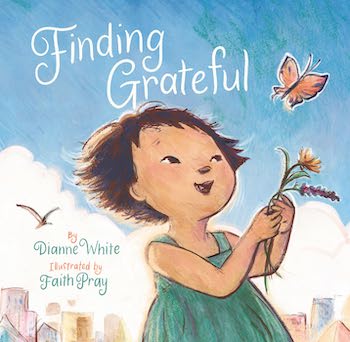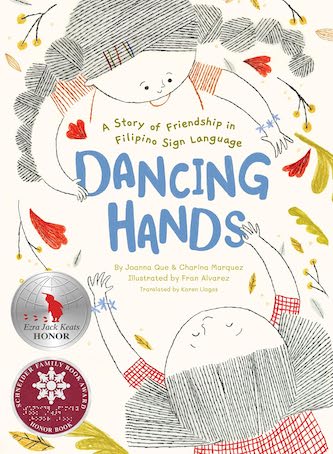Children’s Book Reviews: Finding Connections — Three Picture Books for Kids
By Cyrisse Jaffee
A trio of picture books about people establishing nurturing links.
Finding Grateful by Dianne White. Illustrated by Faith Pray. Chronicle, 2024
Dancing Hands by Joanna Que & Charina Marquez. Illustrated by Fran Alvarez. Translated by Karen Llagas. Chronicle Books, 2023
Room for Everyone by Naaz Khan. Illustrated by Mercè López. Atheneum, 2021

Knowing how to identify, name, and express their feelings enables little ones to develop empathy and self-awareness. In Finding Grateful, a mother tells her little girl, “You don’t need a map to find grateful. It’s as easy as walking in the middle of any time/any place.”
Well, it may not be quite as easy as that. But when their car breaks down in the city, the little girl and her mom find themselves exploring in a way that reveals what it means to be grateful. The little girl notices a flower growing in the sidewalk and gives it to an old woman who smiles. She wonders, “… can grateful be a smile?” She feels the cold spray of a sprinkler and smells the scents of flowers mixed with burgers on a grill in the park. A puppy tickles her toes. A sudden tumble, seemingly not something to be grateful for, brings a comforting hug from mom. But the rest of the day’s adventures are filled with small pleasures, and she thinks, “Maybe it is all of this/that makes my heart as light as/the sun on a while-cloud day.” The car is towed home and she gives thanks: “I’m grateful,” she says, “for this day.”
The pastels of the softly rendered illustrations add an extra touch of sweetness to the story. The little girl is earnestly appealing and the text makes for an easy conversation starter for kids about feelings, gratitude, and noticing the world and people around them.

A different kind of connection is made between Sam and her new neighbor Mai, in Dancing Hands. When they first meet, Sam is curious about how Mai and her family communicate — not with their voices but with “their hands, with the expressions on their faces.” In fact, Mai uses Filipino Sign Language (FSL). “Our new neighbors’ hands are dancing,” Sam says. “Their hands move as if to music.” The two little girls become friends, and Mai teaches Sam her language. Now they can not only better understand each other, they can share their hopes and dreams.
The colored pencil and graphite illustrations are cheerful and engaging, and add a simple yet effective energy to the story. An afterword explains what FSL is, how it’s different from American Sign Language (ASL), and the use of global sign languages around the world. The endpapers provide pictures of words translated into Filipino and then into FSL.
This is a gentle and welcome story about how friendship can overcome language and cultural barriers. The author, Joanna Que, says she was “inspired to write Dancing Hands after joining a writing workshop with Room to Read, a global nonprofit, and Adarna House, a prominent Filipino publisher.” (A portion of the profits from the book will go to Room to Read.) Her co-writer, Charina Marquez, born deaf, is a multitalented artist, baker, and deaf rights advocate. The illustrator, Fran Alvarez, is a member of a Filipino association of artists. All three women live in the Philippines.
The connection generated by community is celebrated in Room for Everyone, a rollicking cumulative tale sent in Tanzania. “The daladala rumbled and roared, and Musa and Dada were off to the shore/to feast on fish/at the Friday bazaar/ by the blue crystal waters of Zanzibar,” the narrative begins. An old man on a broken-down bicycle needs a ride, so he and his bike climb on board. Next, a herder with two little goats joins the crowded vehicle, then vendors with three baskets of fruit, then a farmer with four shiny pails … and so on, up to 10.
Musa is convinced that there can’t possibly be room for each new rider, but Dada reassures him that there’s always room for one more. Sure enough, they shuffle, squirm, squeeze, wiggle and giggle, squish and smush, until the little minibus is overflowing. But they finally arrive at the beach and enjoy the cool waters of Nungwi Beach.

The reader is swept along with the playful storyline, filled with refrains, rhymes, alliteration, and word play. We are on that daladala, sympathizing with Musa’s anxiety, recognizing Dada’s confidence, and appreciating the generosity of the driver and his passengers. The lush illustrations, brightly colored and bouncing all over the page (just like the daladala!), beautifully capture the commotion of the ride as well as the myriad cultures of East Africa. A small glossary defines unfamiliar words, but the essence of the narrative will be familiar to many young readers.
This is not only a terrific read-aloud, it’s also a wonderful portrait of inclusion. The author’s dedication reads, “For travelers everywhere … may you always find comfort, joy, and welcoming strangers on your journey.” What better message for kids whose adventures lie ahead of them!
Cyrisse Jaffee is a former children’s and YA librarian, children’s book editor, and a creator of educational materials for WGBH. She holds a master’s degree in Library Science from Simmons College and lives in Newton, MA.
Tagged: "Dancing Hands", "Finding Grateful", "Room for Everyone", Dianne White, Joanna Que & Charina Marquez
